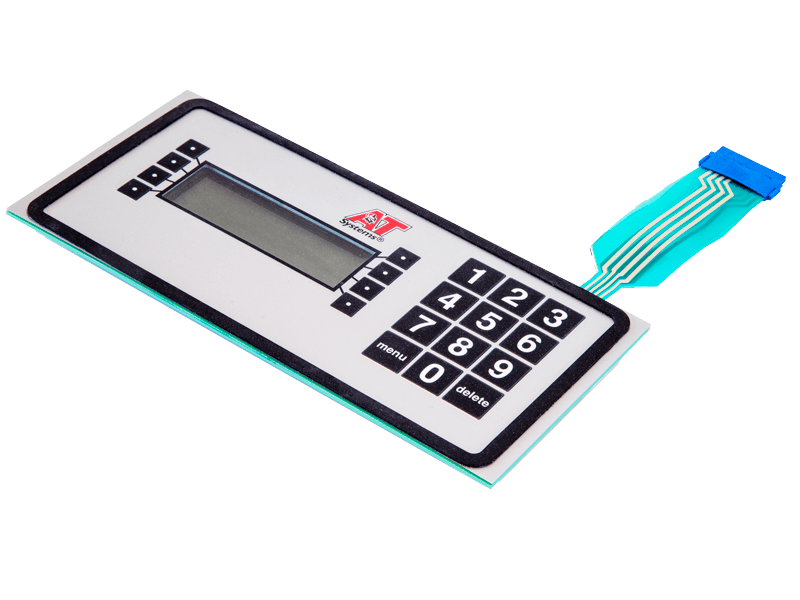Membrane Switch Manufacturer Delivering Fully Custom Solutions
Exploring the Production Refine of Membrane Switch for Different Industries
The production procedure of Membrane switches is an intricate venture that requires accuracy and focus to information. From selecting appropriate materials to executing strenuous quality assurance steps, each step plays a vital function in making certain capability. Different industries, including automobile and medical, count on these components for their unique applications. Recognizing the intricacies of this process reveals considerable understandings right into exactly how these switches are produced and their impact throughout varied fields.
Comprehending Membrane Switches Over: A Review

Secret Materials Utilized in Membrane Switch Production
In Membrane button manufacturing, the choice of key products substantially influences performance and durability. Conductive products, adhesives, and finishes play essential duties, while substrate option influences total efficiency and integrity. Recognizing these parts is necessary for enhancing the layout and production of Membrane buttons.
Conductive Products Overview
Conductive materials play an essential function in the capability of Membrane buttons, guaranteeing reliable electric links within the device. Typically utilized products consist of silver, copper, and carbon-based inks, each offering unique advantages. Silver is preferred for its high conductivity and resilience, making it excellent for applications calling for robust efficiency. Copper, while a little much less conductive than silver, is an affordable choice typically made use of in published circuits. Carbon-based inks offer a versatile choice, appropriate for applications where adaptability and reduced expenses are focused on, although they have actually lower conductivity compared to steel options. The selection of conductive products straight influences the total integrity, life-span, and efficiency of the Membrane button, making it an important factor to consider in the production procedure.
Adhesives and Coatings
Finishes and adhesives are crucial parts in the production of Membrane switches, offering essential bonding and protective buildings. These products assure that numerous layers of the button, including graphic overlays and wiring, stick safely to one another, enhancing toughness and capability. Frequently utilized adhesives include pressure-sensitive adhesives (PSAs) and epoxy-based solutions, which supply solid adhesion and durability. Coatings, such as polyurethane or acrylic, offer to safeguard versus ecological elements, including moisture, abrasion, and chemicals. In addition, layers can improve tactile responses and aesthetic charm, adding to the overall individual experience. The choice of suitable adhesives and layers is essential for optimizing performance and longevity in varied applications across numerous industries, ensuring that Membrane switches fulfill particular functional demands.
Substrate Choice Factors
Substratum selection plays a necessary duty in the manufacturing of Membrane buttons, as it considerably affects their general efficiency and resilience. Key products such as polyester, polycarbonate, and flexible published circuit card (FPCBs) are typically utilized for their distinctive homes. Polyester is preferred for its cost-effectiveness and resistance to abrasion, making it appropriate for applications with high wear. Polycarbonate deals remarkable clearness and influence resistance, ideal for environments calling for high exposure. FPCBs offer enhanced flexibility and are often utilized in complex layouts. The choice of substratum likewise influences elements like thermal security, chemical resistance, and simplicity of printing. Inevitably, selecting the proper substratum is crucial for ensuring the performance and longevity of Membrane switches throughout various markets.
The Design Process of Membrane Switches
The design process of Membrane switches is an important phase that considerably influences the performance and appearances of the last item - membrane switch manufacturer. It begins with defining the specific requirements of the application, consisting of measurements, switch design, and responsive feedback choices. Designers need to take into consideration user interaction, guaranteeing that the switch is user-friendly and accessible.Next, products are picked based on toughness, adaptability, and ecological resistance. The integration of graphics and branding aspects is additionally crucial, as it enhances visual charm and interaction. Prototyping permits iterative screening, making it possible for changes based upon individual feedback and performance evaluations.Additionally, the layout has to make up the electric components, such as circuits and ports, making certain integrity and simplicity of usage. Inevitably, an effective style harmonizes capability, looks, and individual experience, leading the way for reliable production and lasting efficiency in various industries
Printing Strategies for Membrane Switches
The printing methods used in Membrane switch production play a vital role in figuring out the end product's high quality and performance. Display printing supplies benefits such as sturdiness and vibrant shade application, while digital printing technologies supply adaptability and accuracy in design. Understanding these approaches can substantially influence the general efficiency of Membrane switches in various applications.
Display Printing Advantages
Numerous benefits make display printing a recommended method for producing Membrane buttons. This method permits high-grade, lively shades and detailed layouts, which are essential for interface applications. Display printing is especially efficient for using thick ink layers, boosting resilience and tactile comments. Additionally, it offers superb adhesion to various substratums, making sure long life sought after environments. The procedure is affordable for huge manufacturing runs, as it lessens setup time and waste. Additionally, screen printing sustains a variety of inks, consisting of specialty and UV-curable options, enabling flexibility in layout. Its capability to generate regular outcomes throughout several units makes it a dependable choice for suppliers going for top quality and performance in Membrane button production.
Digital Printing Innovations

Improvements in electronic printing innovation are transforming the production of Membrane switches, offering suppliers cutting-edge remedies that boost layout flexibility and effectiveness. Digital printing enables high-resolution graphics and detailed layouts, enabling custom-made branding and functionality without the constraints of standard methods. This strategy lowers arrangement times and prices, assisting in much shorter production runs and minimal waste, making it perfect for businesses with differing demands. Additionally, advancements in ink solutions supply better longevity and attachment, guaranteeing longevity in different environments. As sectors progressively look for individualized and intricate layouts, digital printing attracts attention as a crucial method, establishing a new standard in Membrane button production. The assimilation of these innovations settings manufacturers to satisfy evolving market requires effectively.
Setting up and Layering of Membrane Switch Parts
Careful assembly and layering of Membrane button elements are vital to assuring functionality and longevity. This process begins with the specific positioning of numerous layers, including the graphic overlay, sticky, circuit layer, and support material. Each element must be thoroughly placed to maintain electric integrity and interface responsiveness.During assembly, conductive traces are used to the circuit layer, commonly made from products like polyester or polycarbonate. This layer is critical, as it beams when pressure is used. The glue made use of for bonding these layers is additionally picked for its ability to sustain environmental stress and anxieties while maintaining a safe bond.Heat and stress are typically used throughout the assembly procedure to establish that the layers stick properly without jeopardizing the functionality of the button. Attention is provided to the edge sealing to secure versus wetness and contaminants, protecting the durability of the Membrane switch in different commercial applications.
Quality Control Steps in Membrane Switch Manufacturing
Quality assurance procedures play a crucial duty in making certain the reliability and performance of Membrane switches adhering to the setting up and layering of their elements. In the production process, several essential examinations are carried out to promote quality standards. These include visual inspections for flaws in printing and adhesive application, in addition to useful tests to verify the responsiveness of each switch.Additionally, environmental screening is executed to examine the switches' durability versus temperature level changes and moisture direct exposure. Producers often carry out statistical procedure control (copyright) techniques to monitor manufacturing consistency, enabling early discovery of anomalies.Furthermore, traceability systems are established to track components and products, making sure liability and promoting recalls if necessary. Calibration of equipment and adherence to market standards are also important to keeping product integrity. Jointly, these high quality control measures safeguard the efficiency of Membrane changes throughout different applications, inevitably boosting consumer contentment.
Applications of Membrane Changes Across Different Industries
Membrane switches are utilized across a varied variety of industries, showcasing their flexibility and flexibility. In the clinical industry, they offer dependable and waterproof user interfaces for tools such as analysis tools and mixture pumps, making certain hygiene and convenience of usage. The automobile sector uses Membrane switches for control panel controls, allowing seamless interaction in between the vehicle driver and lorry systems.In customer electronic devices, these buttons are found in appliances and portable devices, supplying a sleek, contemporary visual while improving functionality. Industrial applications likewise utilize Membrane switches for machinery control board, where longevity and resistance to harsh conditions are essential.Furthermore, the aerospace and defense markets utilize Membrane buttons for cabin instrumentation and interaction systems, prioritizing integrity and performance under severe conditions. In general, Membrane switches play an essential duty in improving the individual experience and operational effectiveness across numerous domain visit site names.
Regularly Asked Questions
How much time Does It Take to Make a Membrane Switch?
The production time for a membrane button usually ranges from a couple of days to numerous weeks - membrane switch manufacturer. Factors influencing this duration include design intricacy, product schedule, and production volume, all influencing the general timeline considerably
What Is the Typical Life Expectancy of a Membrane Layer Switch?
The common lifespan of a membrane button usually varies from 1 to 5 million actuations, depending upon elements such as material high quality, ecological conditions, and usage regularity, significantly affecting longevity and general efficiency.
Can Membrane Switches Be Custom-made for Particular Applications?
Membrane buttons can certainly be personalized for specific applications. Their layout adaptability enables alterations in dimension, form, colors, and graphics, making sure compatibility with distinct requirements across various industries and improving capability and individual experience.

Are Membrane Switches Eco-friendly?
The environmental impact of Membrane changes differs. Some products utilized may not be eco-friendly, while developments in making processes are progressively concentrating on sustainability, intending to minimize waste and promote recyclable components in their manufacturing.
What Are the Common Failure Settings of Membrane Switches?
Usual failing settings of Membrane buttons consist of delamination, sticky failure, deterioration from usage, moisture ingress, and electric failings. These problems can significantly influence functionality, efficiency, and lifespan in different applications across different markets. Membrane switches can be tailored to fit certain style requirements, such as capability, form, and dimension, making them highly adaptable.The construction commonly entails several layers, consisting of a graphic overlay, glue, and a circuit layer, which work with each other to produce a seamless user experience. In Membrane switch production, the choice of key products significantly affects capability and toughness. The automotive market employs Membrane buttons for control panel controls, allowing smooth communication in between the chauffeur linked here and lorry systems.In consumer electronic devices, these buttons are found in devices and portable gadgets, using a sleek, modern visual while enhancing functionality. Industrial applications likewise leverage Membrane switches for machinery control panels, where durability and resistance to severe conditions are essential.Furthermore, the aerospace and defense fields utilize Membrane switches for cockpit instrumentation and communication systems, prioritizing integrity and this post performance under extreme conditions. Membrane buttons can indeed be tailored for details applications.